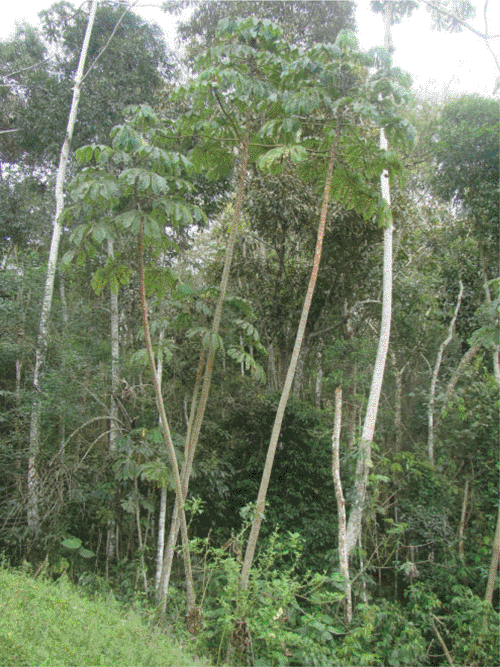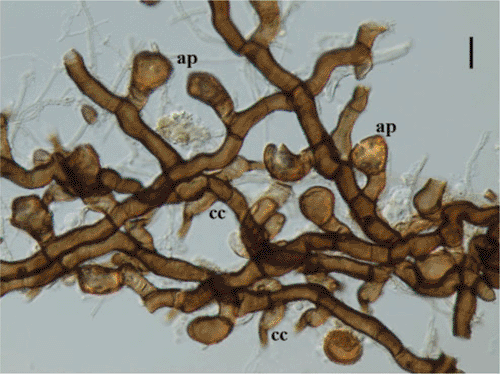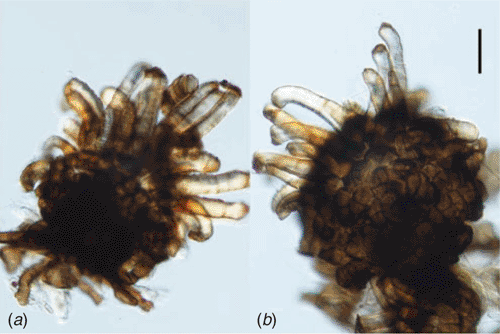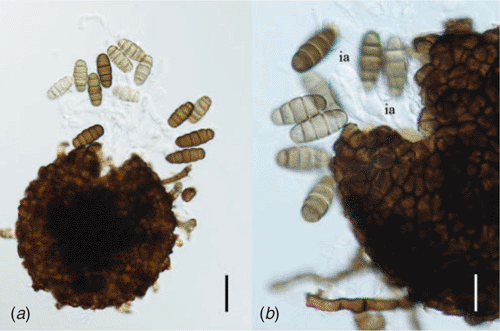Black mildew disease on the neotropical tree Cecropia glaziovi in Brazil, caused by Appendiculella echinus
O. L. Pereira A B and M. Silva AA Departamento de Fitopatologia, Universidade Federal de Viçosa, 36570-000, Viçosa, MG, Brazil.
B Corresponding author. Email: oliparini@ufv.br
Australasian Plant Disease Notes 4(1) 4-5 https://doi.org/10.1071/DN09002
Submitted: 14 October 2008 Accepted: 16 January 2009 Published: 9 February 2009
Abstract
Appendiculella echinus belongs to the order Meliolales. The fungi of this group are known as black mildews. A. echinus was observed on leaves of Cecropia graziovi in the ‘Reserva Florestal da Mata do Paraíso’ in the state of Minas Gerais, Brazil. This is the first record of A. echinus on C. graziovi and the second host record for this fungus in Brazil, previously known only from Coussapoa sp.
Introduction
Cecropia graziovi Snethl. (known in Brazil as ‘embaúba’) is a pioneer forest species belonging to the Cecropiaceae, which occurs in the Brazilian Atlantic Rain Forest, especially in the forest borders and secondary forests. Its fruits, twigs and leaves are important food sources for Bradypus species in the neotropics and are also used in Brazilian folk medicine for multiple purposes.
Materials and methods
In May 2008, plants of C. glaziovi (Fig. 1) were found colonised by a species of Meliolales (black mildew) in the ‘Reserva Florestal da Mata do Paraíso’, Viçosa city, state of Minas Gerais, Brazil. Samples of infected leaves were collected, photographed and dried in a plant press. Observations and measurements were carried out by means of a Carl Zeiss Standard W and photographs by means of an Olympus BX 51 light microscope fitted with a digital camera (Evolt E330). Wherever possible, 30 measurements were made of the structures mounted.

|
Taxonomic description
Appendiculella echinus (P. Henn.) Hoehn. (Figs 2–4) A description of the fungus on host tissue follows. Colonies on the adaxial surface of leaves, mostly epiphyllous, black, velvety, scattered, numerous, up to 3 mm in diameter. Internal mycelium not observed. Dark brown hyphae, septate, straight to undulate, branching opposite at an acute to wide angle, mycelial cells 12.5–37.5 × 7.5–12.5 μm, closely reticulate, producing appressoria and few phialides. Appressoria alternate to unilateral, brown, straight to curved; stalk cells cuneate to cylindrical, 5.0–15.0 × 6.0–11.0 μm. Head cells ovate or elliptical, lobate or angulose, 14.0–24.0 × 12.5–22.5 μm. Conidiogenous cells few, mixed with appressoria, alternate to opposite, ampulliform, brown, 20.0–22.5 × 10.0–12.5 μm. Larviform appendages, numerous, light brown, transversely striate, grouped around the perithecia apex, curved, 27.5–65.0 × 7.5–22.5 μm. Perithecia black, scattered, globose, verrucose, 92.5–200 μm diameter, surface cells conoid, with numerous larviform appendages. Asci evanescent, 2 ascospores per ascus. Ascospores elliptic, rounded at the tips, 40.0–50.0 × 16.0–17.5 μm, smooth, 4-septate, constricted at the septa, dark brown.

|

|

|
Material examined: Brazil. Reserva Florestal da Mata do Paraíso, Viçosa, State of Minas Gerais, on leaves of Cecropia graziovi, 19 May 2008, O.L. Pereira VIC 30701.
The black mildew fungus found on C. graziovi belongs to the genus Appendiculella. This genus has perithecia with larviform appendages and differs from Irenopsis by the presence of perithecial setae on the latter. Meliola have setae on external mycelia and Asteridiella differs from all others by its glabrous perithecia and mycelia (Hansford 1961). Only two species belonging to Meliolales are known to occur on Cecropia spp. (Hansford 1961) viz. Appendiculella echinus (P. Henn.) Hoehn. has been reported on Cecropia sp. in British Guiana, A. echinus var. dominguensis Hansf. has been reported on Cecropia peltata L. in Dominican Republic and A. tonkinensis (K. & R.) Toro var. cecropiae (Stev.) Hansf. has been reported on two other Cecropia spp. in Panama. The microscopic observations of C. graziovi matched with the description of A. echinus, a species previously reported in Brazil, but only on Coussapoa sp. (Hansford 1961). This is therefore the first report of A. echinus on leaves of C. graziovi.



